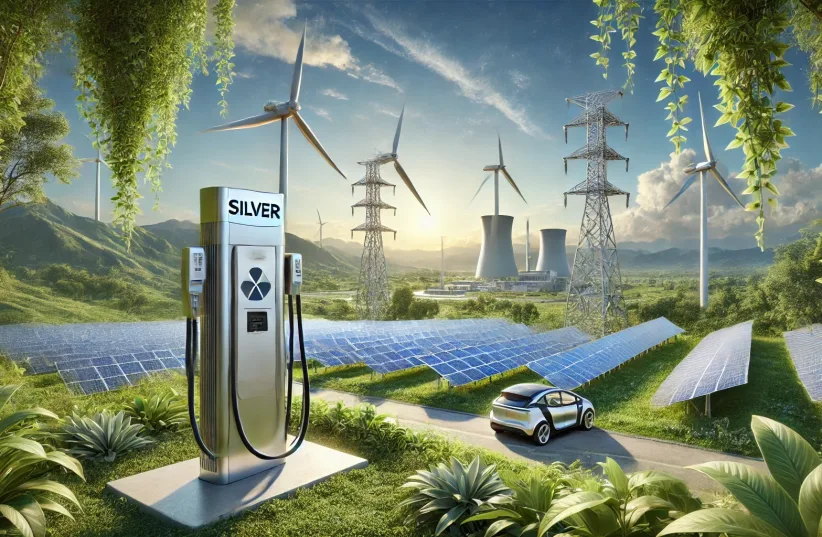
From solar panels to electric vehicles, silver is at the heart of groundbreaking innovations in clean energy. Discover how this precious metal is revolutionizing the future of sustainable power.
In an era where the global push for sustainable energy solutions has never been more urgent, an unexpected hero is emerging from the periodic table: silver. This precious metal, long valued for its monetary and decorative uses, is now proving indispensable in the green technology revolution, playing crucial roles in everything from solar panels to advanced battery systems.
The Silver Lining in Green Technology
Silver stands as the most electrically conductive element in the periodic table, making it not just a precious metal, but an irreplaceable industrial commodity. This exceptional metal’s fundamental properties have positioned it at the forefront of technological innovation and industrial applications.
What sets silver apart is its unrivaled combination of physical properties. The metal possesses the highest electrical conductivity of any element, coupled with superior thermal conductivity that makes it essential for high-performance applications. Its unparalleled reflective properties make it crucial in solar technology, while its natural antimicrobial characteristics open up vital applications in medical and water purification technologies. Furthermore, silver’s exceptional malleability and ductility allow it to be formed and shaped into various configurations necessary for modern manufacturing processes.
These extraordinary characteristics have positioned silver as an essential component across multiple sectors, with green technology representing just one facet of its growing industrial importance. The surge in demand from renewable energy applications adds to an already robust industrial consumption base, creating what industry analysts describe as a “perfect storm” of demand pressure.
Solar Power:
Silver’s most significant impact in renewable energy comes from its use in photovoltaic cells. Modern solar panels rely heavily on silver paste for conducting electricity from sunlight. Each solar panel contains approximately 20 grams of silver, making the solar industry one of the largest industrial consumers of the metal.
Industry experts project that silver demand from the solar sector alone could reach 8,000 metric tons annually by 2025, representing a 50% increase from current levels.
Silver-Based EV Batteries
In a groundbreaking development, researchers have made significant strides in silver battery technology, potentially offering a more efficient and sustainable alternative to traditional lithium-ion batteries. These new silver-based batteries demonstrate:
- 40% longer lifespan than conventional lithium-ion batteries
- Faster charging capabilities
- Reduced environmental impact
- Lower production costs at scale
- Enhanced safety features with reduced risk of thermal runaway
Nuclear Energy: Silver’s Critical Role
In nuclear power plants, silver plays a vital but often overlooked role. The metal is used in control rods that help regulate nuclear reactions, while silver-based components are essential in safety systems and radiation monitoring equipment.
Wind Energy and Water Purification
The renewable energy sector’s reliance on silver extends to wind turbines, where the metal’s superior conductivity properties make it ideal for various electrical components and control systems. Additionally, silver’s natural antimicrobial properties have made it increasingly important in water purification systems, with many modern filtration technologies incorporating silver nanoparticles.
Key Takeaways:
- Silver is essential in solar panel production, with demand expected to surge 50% by 2025
- New silver-based batteries show superior performance compared to lithium-ion alternatives
- The metal plays crucial roles in nuclear power safety systems
- Silver’s applications in wind energy and water purification are expanding
- Growing demand from green technology could impact global silver prices and availability
Analysis
The increasing adoption of silver in green technologies presents both opportunities and challenges, but it’s crucial to understand that this is just one piece of a much larger puzzle. Silver’s unique properties make it indispensable across multiple critical sectors:
- Military Applications: Silver is essential in advanced defense systems, radar technology, and missile guidance systems
- Medical Industry: The metal’s antimicrobial properties make it vital in surgical instruments, wound dressings, and advanced medical devices
- Traditional Jewelry: Continues to drive significant demand globally
- Electronics: Present in virtually every modern electronic device, from smartphones to aerospace technology
This diversified demand profile, coupled with relatively constrained global production, positions silver as a potentially superior store of wealth. While technical advantages in green technology are clear, the combined demand from all sectors could lead to unprecedented supply pressure. Annual silver mining production, currently around 800 million ounces, is struggling to keep pace with growing industrial requirements.
The convergence of these factors – green technology expansion, diverse industrial applications, and limited production capacity – suggests we may witness a meteoric rise in demand against a backdrop of constrained supply. This fundamental imbalance could make silver an increasingly attractive investment vehicle, potentially offering both industrial utility and monetary preservation benefits.
While ongoing research into more efficient use of silver and recycling technologies could help mitigate some supply concerns, the sheer breadth of silver’s applications across critical industries makes it uniquely positioned as a store of wealth in an increasingly technology-dependent world.
Looking Ahead
The future is indeed looking silver, as this versatile metal emerges as not just a cornerstone of sustainable energy, but as a crucial component in the broader technological revolution reshaping our world. For investors and industry stakeholders alike, silver’s dual role as both an industrial metal and a store of value makes it an increasingly strategic asset in an evolving global economy.

















